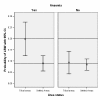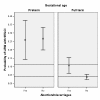Risk factors for low birthweight in the public-hospitals at Peshawar, NWFP-Pakistan
- PMID: 18533023
- PMCID: PMC2435119
- DOI: 10.1186/1471-2458-8-197
Risk factors for low birthweight in the public-hospitals at Peshawar, NWFP-Pakistan
Abstract
Background: Low birthweight is a widely used indicator of newborn health. This study investigates the association of birthweight <2.5 kg (LBW) with a wide range of factors related to geo-demographics, maternal health and pregnancy history in public hospitals at Peshawar, North West Frontier Province (NWFP) Pakistan. It is noted that that Low birthweight may arise for two different reasons, one related to gestational age and the other corresponding to births that are small for gestational age (SGA).
Methods: Data on geo-demographics, maternal health indicators, pregnancy history and outcome scores for newborn babies and their families (n = 1039) were collected prospectively between August and November 2003 in a cross-sectional survey of four public hospitals in Peshawar, NWFP-Pakistan. Crude and adjusted odds ratios were used to investigate the factors affecting incidence of LBW, by multivariate logistic regression. Gestational age was included as an explanatory variable therefore the additional covariates identified by model selection are expected to account for SGA.
Results: The main geo-demographic risk factors for SGA identified in this study, controlling for gestational age of less than 37 weeks, are maternal age, nationality and consanguinity. Presentation with anaemia and the history of previous abortion/miscarriage were also found to be significant independent factors. The adjusted odds ratio for gestational age showed the largest effect in explaining the incidence of LBW. The next highest odds ratio was for maternal age below 20 years. The explanatory model included two pairwise interactions, for which the predicted incidence figures for LBW show an increase among the Tribal area with presentation of anaemia, and among full term babies with their mothers having a previous history of abortion/miscarriage.
Conclusion: In addition to gestational age, specific factors related to geo-demographics (maternal age, consanguinity and nationality), maternal health (anaemia) and pregnancy history (abortion/miscarriage) were significantly associated with the incidence of LBW observed at the four hospitals surveyed in Peshawar. These results indicate that cultural factors can adversely affect the incidence of SGA in this area of Pakistan.
Figures



References
-
- UNICEF Low Birth Weight, Country Regional and Global estimates http://www.unicef.org/publications/index_24840.html Accessed July 13, 2005.
-
- de Onis M, Blossner M, Villar J. Levels and patterns of intrauterine growth retardation in developing countries. Eur J Clin Nutr. 1998;52:S5–15. - PubMed
-
- UNDP Infants with low birth weight http://hdrstats.undp.org/indicators/67.html Accessed December 17, 2006.
Publication types
MeSH terms
LinkOut - more resources
Full Text Sources

